Anglo vs English Concertina: A Complete Guide to Choosing Your Squeezebox
Of all the questions new players have, the Anglo vs English concertina choice is the biggest. This one decision shapes everything about your playing journey.
The main difference is how they make notes, which changes the music you can play and how you learn.
This guide will make sense of it all. We will look at how each one works, the music they are made for, and which might be the right fit for you.
By the end, you’ll have a clear idea of which of these classic instruments belongs in your hands.
What’s the Core Difference: Anglo vs English Concertina?
The most important thing to know in the Anglo vs English concertina puzzle is how the bellows work. The bellows are the folded part in the middle that you push and pull. This one action is what makes the two instruments so different.
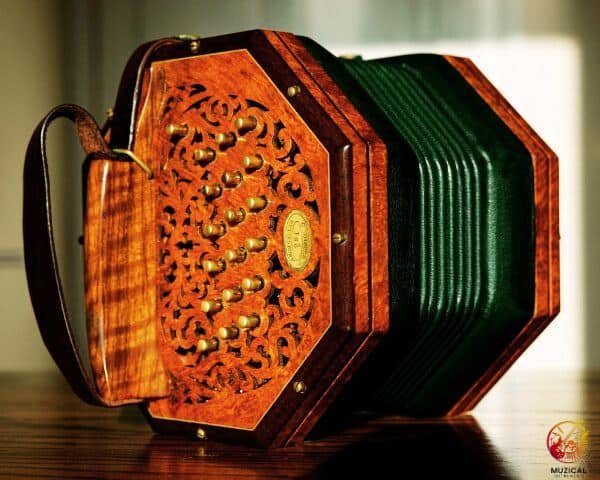
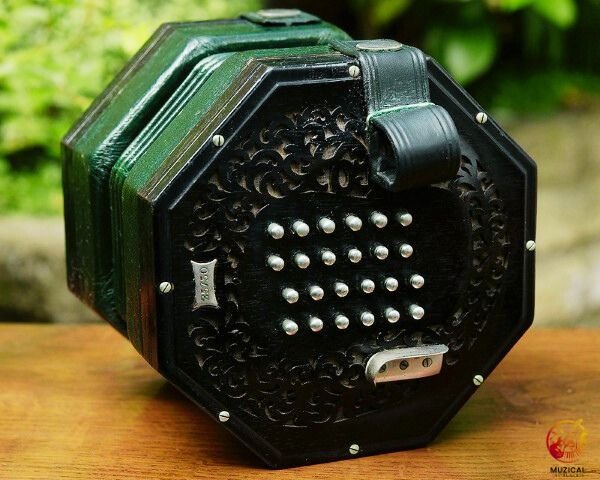
The English concertina is unisonoric. That’s a fancy word, but it just means “one sound.” Any button you press plays the same musical note, whether you are pushing in or pulling out. If you press a C button, you get a C on the push and a C on the pull.
This makes it very logical and easy to understand. It has all the notes, including sharps and flats, like a piano. This setup is great for playing smooth, flowing tunes where you need any note at any time.
The Anglo concertina is bisonoric, which means “two sounds.” Every button plays two different notes. You get one note when you push the bellows in and a completely different note when you pull out. It works a lot like a mouth organ or harmonica.
This push-pull style is what gives the Anglo its unique, bouncy sound. You have to keep changing bellows direction to play a tune, which forces a very rhythmic style of playing.
How Do the Buttons Change the Music You Play?
The way the buttons are laid out on each concertina directly affects the kind of music that feels easy and natural to play on it.
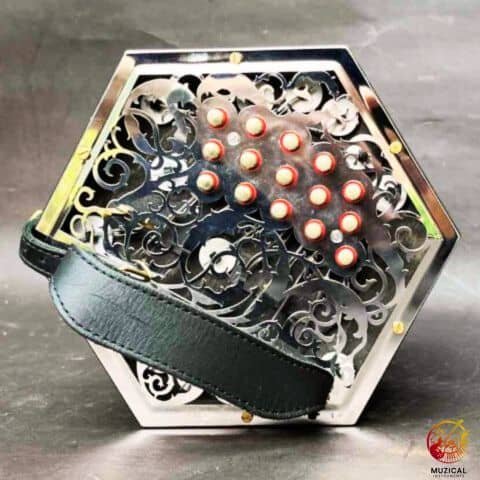
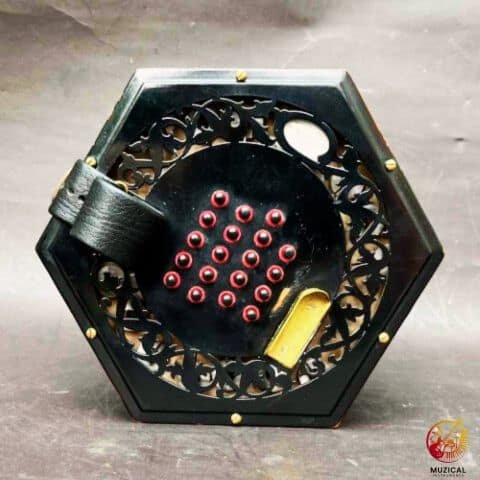
On an English concertina, the buttons are set in straight rows that run parallel to each other. Your fingers travel up and down these rows to play scales and tunes. Because it has all the notes (it’s a chromatic instrument), you can play in any key. This layout is perfect for people who read sheet music.
Think about playing a slow, pretty folk song. The English layout lets your fingers move from note to note in a very orderly way, just as you’d see them on a page. You can easily hold a long note with one hand and play a harmony with the other.
The Anglo concertina’s buttons are completely different. They are set up in arced rows. Each row is tuned to a different musical key. The most common kind is a C/G Anglo. This means one row gives you the notes for the key of C, and the other row gives you the notes for the key of G. This design is brilliant for playing folk music with a strong rhythm.
The notes for a chord are often grouped close together, so you can play tunes that have a built-in punch. This is why it’s the top choice for Irish traditional music, where the driving beat is king.
Anglo vs. English Concertina at a Glance
| Feature | English Concertina | Anglo Concertina |
|---|---|---|
| Sound System | Unisonoric: Same note, push or pull. | Bisonoric: Different note on push vs. pull. |
| Notes | Chromatic: Has all the notes. | Diatonic: Set in specific keys (like C/G). |
| Button Layout | Straight rows. | Arced rows. |
| Best For | English Folk, Singer Accompaniment, Salvation Army Bands. | Irish Traditional Music, Morris Dancing, Sea Shanties. |
| Playing Feel | Smooth and flowing. | Punchy and rhythmic. |
| How You Hold It | Thumb straps and pinky rests. | Straps over the back of your hands. |
Which Concertina Fits the Music I Want to Play?
Your final choice in the Anglo vs English concertina matchup should come down to the music you love. While an expert can play almost anything on either, each one is built to make certain styles easier.
Do you see yourself playing fast, lively tunes in an Irish pub? Do you love the energy of Morris dancing or the sound of bold sea shanties? If you said yes, the Anglo concertina is your best bet. Its push-pull system creates the pulse and rhythm that drive these kinds of music.
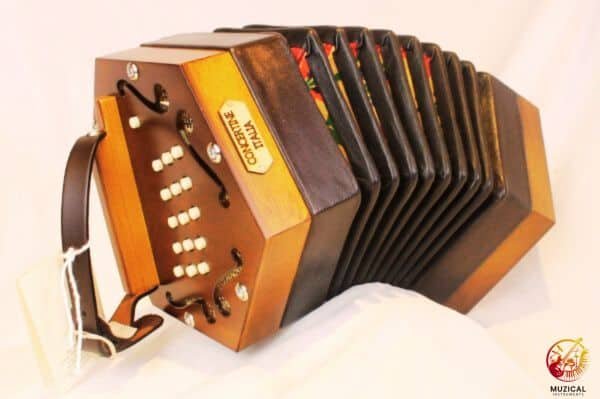
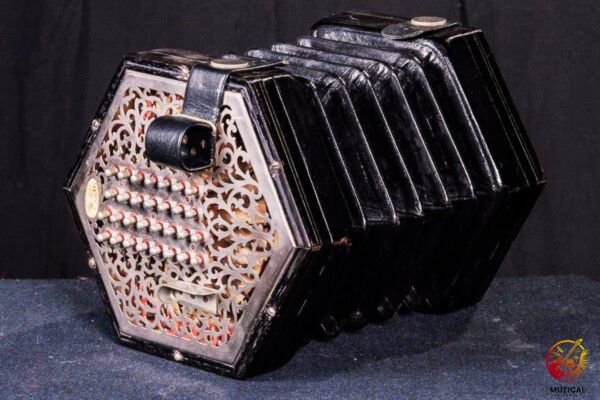
The standard C/G Anglo is perfect for the huge number of tunes played in the keys of G and D, which are the bread and butter of Irish and English folk. The ability to punch out chords makes it sound powerful and exciting.
But maybe your musical goals are different. If so, the English concertina could be the right choice. Are you a singer who wants an instrument to play chords behind your voice? Do you want to play pretty English folk melodies exactly as they were written?
The English concertina’s system gives you the freedom to do this. It lets you hold notes for a long time and play complex chords. It can play in any key you want without any trouble. This makes it a great all-around tool for a musician who wants to do many different things.
Expert Insight: Don’t Get Boxed In
These are not strict rules! Some amazing players use the English concertina for Irish music, and some Anglo players are great at playing soft, slow songs. But you should pick the instrument that gives you the easiest path to the music you want to play most of the time.
What About the Different Keys of Anglo Concertinas?
This is another key point of difference in the Anglo vs English concertina world. The English concertina can play in any key. But the Anglo is a diatonic instrument, which means it is built to play in just a few keys. You have to pick the right tool for the job.
The most common and useful type is the C/G Anglo concertina. This means one main row of buttons plays the C major scale, and the other plays the G major scale. This setup gives you easy access to tunes in G, C, D, and their related minor keys. This covers a very large amount of the folk music you’ll find, which is why the C/G is what most teachers suggest for beginners. It’s the best all-rounder to get you started.
But it’s not the only choice. Some players who focus only on Irish music prefer a G/D concertina. It’s tuned a bit lower than a C/G, which gives it a warmer, sadder sound that many people love.
For other styles, like old-time Morris dance music, players sometimes used a Bb/Eb concertina so they could play along with brass instruments. When you choose an Anglo, you are also choosing which keys you’ll be able to play in easily.
Common Anglo Concertina Tunings
| Tuning | Main Keys | Best For | Sound |
|---|---|---|---|
| C/G | G, C, D | Standard for Irish & English folk. The best starter choice. | Bright and clear. |
| G/D | G, D, A | Popular for specific styles of Irish music. | Mellow and a bit lower. |
| Bb/Eb | Bb, Eb, F | Used in Morris bands to play with brass instruments. | Lower and blends well with horns. |
Which Is Easier for a Beginner to Learn?
This is a tough question and a big part of the Anglo vs English concertina decision. The honest answer is: it depends on you and how you learn.
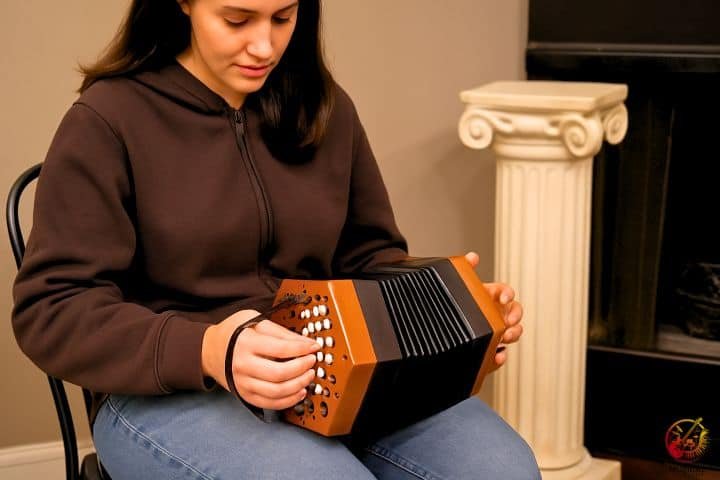
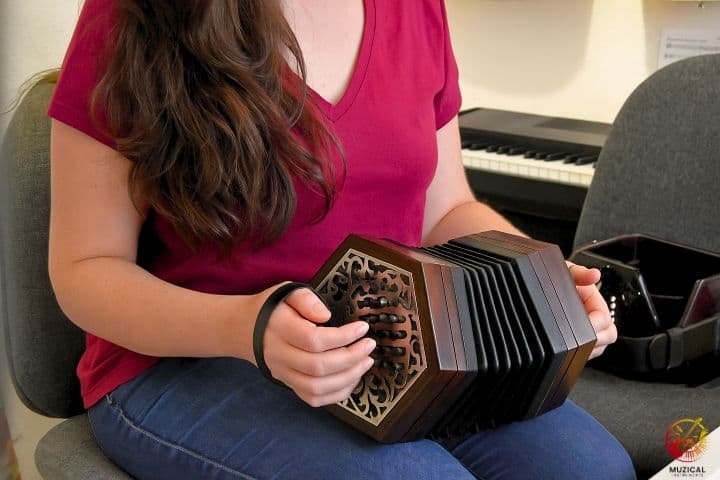
You could say the English concertina is easier to understand at the very beginning. Its system is very logical: one button is one note, period. If you already read music or think of tunes as a simple line of notes, the English system will make sense right away. The main skill to learn is memorizing the button locations and getting your fingers to move smoothly. The bellows are mostly for expression, not for finding notes.
The Anglo concertina is a different story. The first step is a big one. You have to learn the push pull system. To play a simple scale, you have to change your bellows direction several times. This can feel tricky at first. But once you get the hang of it, many players find the Anglo layout feels more natural for playing folk tunes. The notes seem to be right where you need them, and the rhythm becomes a part of how you play.
Pro Tip for New Players: If you pick the Anglo, start simple. Learn a very easy tune using only the buttons on one row. This lets you get used to the push-pull motion without having to worry about moving between rows. It builds a solid foundation.
So, the English is easier to grasp mentally, but the Anglo can feel more intuitive physically once you get past that first learning curve.
How Do They Feel and Sound?
Finally, let’s talk about the feel and sound. The physical experience of playing an Anglo vs English concertina is very different.
You hold an English concertina with thumb straps. Your thumbs go in the straps, and your pinkies often rest on small metal ledges. This leaves your other three fingers on each hand free to press the buttons. This grip helps you play the clean, clear notes the instrument is famous for.
The Anglo concertina uses wide leather straps that go over the back of your hands. This holds the instrument very securely. You need this strong grip because of the hard push-pull bellows work used in the Anglo style. It lets you put your whole arm into the music, giving it a strong, physical energy.
The sound is also easy to tell apart. The English concertina has a “sweet” and “flute like” sound. It’s very clear, which is great for complex melodies and harmonies.
The Anglo sounds “bright,” “raw,” and “punchy.” Its reeds (the small metal parts that vibrate to make the sound) are often made of steel, which gives it a loud and exciting tone that can be heard in a noisy room. The Anglo vs English concertina is not just a mechanical choice; it’s a choice of sound and feeling.
Final Thoughts: Making Your Choice
Deciding between an Anglo vs English concertina isn’t about which one is better overall. It’s about which one is better for you.
The English concertina is a logical, chromatic instrument with a sweet sound, perfect for melodies and accompanying your voice.
The Anglo concertina is a rhythmic, diatonic powerhouse with a punchy sound, built for driving folk tunes.
Your next step is to listen. Search for videos of both and see which sound speaks to you. If possible, try to hold both.
Now that you know what to look for in the Anglo vs English concertina debate, trust your ear and your heart to guide you to the right instrument.
Frequently Asked Questions (FAQ)
Here are answers to some common questions people have when trying to decide in the Anglo vs English concertina debate.
1. What is the best concertina for a beginner?
This really depends on the music you want to play. There is no single “best” one for everyone.
Choose the English concertina if you want to play smooth melodies and prefer a logical system where one button always makes one note.
Choose the Anglo concertina if your goal is to play upbeat, rhythmic folk music like Irish tunes or sea shanties.
The most important advice is to listen to both and pick the one that makes the sound you want to create.
2. What kind of concertina is used for Irish music?
The Anglo concertina is almost always the choice for Irish traditional music. The bisonoric (push-pull) system gives jigs and reels the punchy, driving rhythm that is key to the style. Most players in this genre use a 30-button Anglo concertina in the key of C/G.
3. Can you play chords on an English concertina?
Yes, absolutely. The English concertina is excellent for playing chords. Because each button plays the same note in or out, you can press multiple buttons to form a chord and hold it for as long as you want. This makes it a great instrument for playing along with a singer or another musician.
4. Is a concertina the same as an accordion?
No, they are different instruments, even though they look a bit similar. Both use bellows to push air through reeds to make sound. But on a concertina, you press buttons that travel in the same direction as the bellows. On an accordion, you have a piano-style keyboard or buttons on one side, and the keys move at a right angle to the bellows. They also have very different sounds and are used for different styles of music.
5. How much does a good beginner concertina cost?
You should expect to pay between $400 and $700 for a good quality beginner concertina, either Anglo or English. There are much cheaper options available online, sometimes under $200, but we strongly advise against them. These instruments are often very difficult to play, go out of tune easily, and can be so frustrating that they make people give up. It’s a much better investment to get a reliable student model that is fun to play.
6. What does a “30-button Anglo” mean?
This tells you how many buttons are on the instrument. A basic Anglo has 20 buttons (two rows of five on each side). A 30-button Anglo adds a third row on each side. This extra row is very important because it gives you the missing sharp and flat notes (accidentals) you need to play more tunes in more musical keys. Almost all players and teachers recommend getting a 30-button model if you are serious about learning the Anglo concertina.
